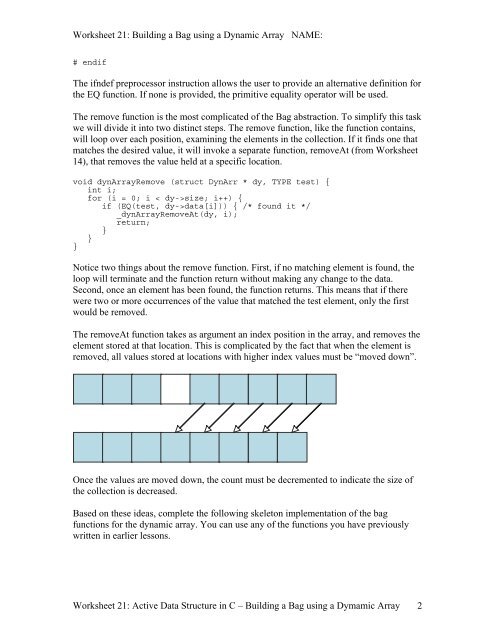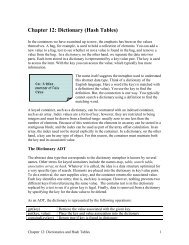Worksheet 21: Building a Bag using a Dynamic Array - Classes
Worksheet 21: Building a Bag using a Dynamic Array - Classes
Worksheet 21: Building a Bag using a Dynamic Array - Classes
You also want an ePaper? Increase the reach of your titles
YUMPU automatically turns print PDFs into web optimized ePapers that Google loves.
<strong>Worksheet</strong> <strong>21</strong>: <strong>Building</strong> a <strong>Bag</strong> <strong>using</strong> a <strong>Dynamic</strong> <strong>Array</strong> NAME:<br />
# endif<br />
The ifndef preprocessor instruction allows the user to provide an alternative definition for<br />
the EQ function. If none is provided, the primitive equality operator will be used.<br />
The remove function is the most complicated of the <strong>Bag</strong> abstraction. To simplify this task<br />
we will divide it into two distinct steps. The remove function, like the function contains,<br />
will loop over each position, examining the elements in the collection. If it finds one that<br />
matches the desired value, it will invoke a separate function, removeAt (from <strong>Worksheet</strong><br />
14), that removes the value held at a specific location.<br />
void dyn<strong>Array</strong>Remove (struct DynArr * dy, TYPE test) {<br />
int i;<br />
for (i = 0; i < dy->size; i++) {<br />
if (EQ(test, dy->data[i])) { /* found it */<br />
_dyn<strong>Array</strong>RemoveAt(dy, i);<br />
return;<br />
}<br />
}<br />
}<br />
Notice two things about the remove function. First, if no matching element is found, the<br />
loop will terminate and the function return without making any change to the data.<br />
Second, once an element has been found, the function returns. This means that if there<br />
were two or more occurrences of the value that matched the test element, only the first<br />
would be removed.<br />
The removeAt function takes as argument an index position in the array, and removes the<br />
element stored at that location. This is complicated by the fact that when the element is<br />
removed, all values stored at locations with higher index values must be “moved down”.<br />
Once the values are moved down, the count must be decremented to indicate the size of<br />
the collection is decreased.<br />
Based on these ideas, complete the following skeleton implementation of the bag<br />
functions for the dynamic array. You can use any of the functions you have previously<br />
written in earlier lessons.<br />
<strong>Worksheet</strong> <strong>21</strong>: Active Data Structure in C – <strong>Building</strong> a <strong>Bag</strong> <strong>using</strong> a Dymamic <strong>Array</strong> 2

















